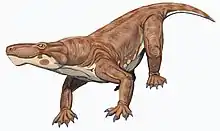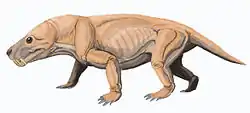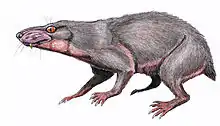Choerosaurus
Choerosaurus is an extinct genus of therocephalian therapsids from the Late Permian of South Africa. The type species Choerosaurus dejageri was named by South African paleontologist Sidney H. Haughton from the Tropidostoma Assemblage Zone in 1929.
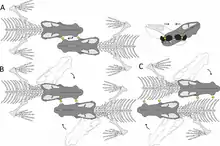
| Choerosaurus Temporal range: Late Permian | |
|---|---|
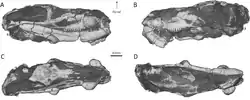 | |
| 3D-rendered skull | |
| Scientific classification | |
| Kingdom: | Animalia |
| Phylum: | Chordata |
| Clade: | Therapsida |
| Suborder: | †Therocephalia |
| Superfamily: | †Baurioidea |
| Genus: | †Choerosaurus Haughton, 1929 |
| Type species | |
| †Choerosaurus dejageri Haughton, 1929 | |
Choerosaurus is similar in appearance to Scaloposaurus. In both Choerosaurus and Scaloposaurus, the back of the skull (called the occiput) is high and the canine teeth are thick and shortened. Choerosaurus also has teeth that are ankylothecodont, meaning that they are fused to the bone of the jaw and would not have been replaced when it was alive.[1]
Choerosaurus was traditionally classified in the Scalopodontia, a group of small therocephalians. Scalopodontians are now thought to be a polyphyletic grouping of mostly juvenile therocephalians, and most taxa are now classified as basal members of Baurioidea. The position of Choerosaurus within Baurioidea is uncertain, as it has never been incorporated in a phylogenetic analysis.[2]
References
| Wikimedia Commons has media related to Choerosaurus. |
- Ivakhnenko, M.F. (2011). "Permian and Triassic therocephals (Eutherapsida) of Eastern Europe". Paleontological Journal. 45 (9): 981–1144. doi:10.1134/S0031030111090012.
- Abdala, F.; Rubidge, B. S.; Heever, J. A. van den (2008). "The oldest therocephalians (Therapsida, Eutheriodontia) and the early diversification of Therapsida". Palaeontology. 51 (4): 1011–1024. doi:10.1111/j.1475-4983.2008.00784.x.
